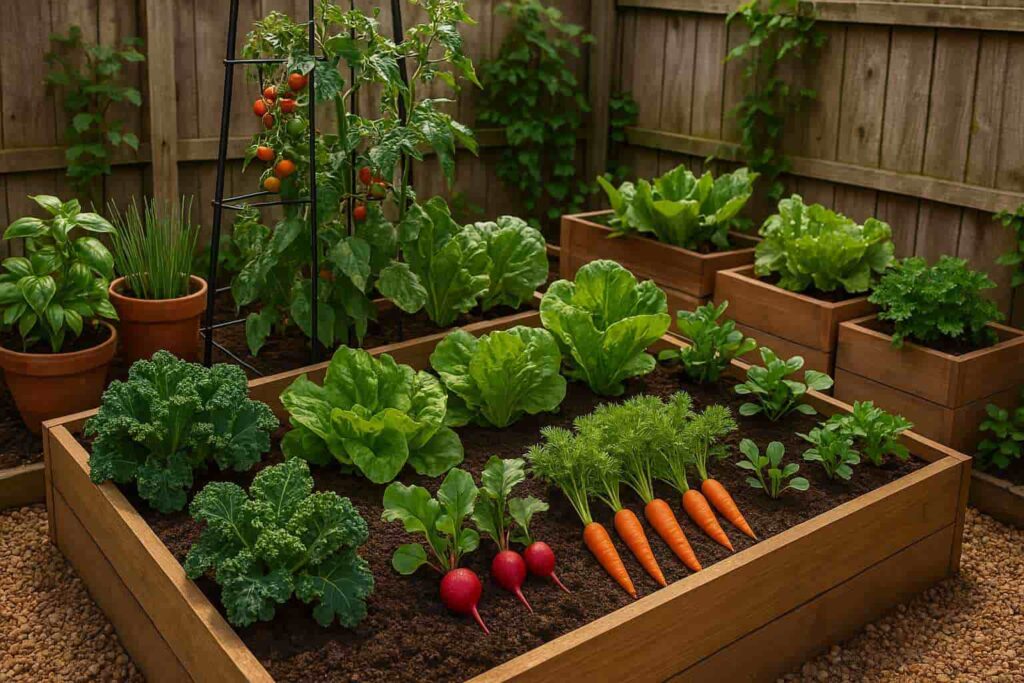
In an age where urban living dominates and outdoor space is often a luxury, many assume that growing your own vegetables is out of reach. But here’s the truth—you don’t need acres of land or a countryside retreat to cultivate fresh, homegrown produce. All it takes is a little creativity, the right setup, and a passion for planting.
Whether you’re working with a balcony, a courtyard, or a compact backyard, your dream of harvesting crunchy carrots, vibrant tomatoes, and fragrant herbs can become reality. Let’s dig in.
🌱 Why Grow Your Own Vegetables?
Growing your own vegetables offers more than just food:
- Healthier meals: No chemicals, pesticides, or long supply chains.
- Cost-effective: A small packet of seeds can feed you for months.
- Sustainability: Reduce food miles and packaging waste.
- Therapy: Gardening is proven to reduce stress and promote mental well-being.
Even a few pots or raised beds can yield an impressive amount of produce.
🧩 Planning Your Space
Step 1: Assess Your Environment
Observe how much sun your garden gets. Most vegetables need 6–8 hours of sunlight daily, so choose the sunniest spots for crops like tomatoes, peppers, and squash.
Step 2: Use Vertical Space
When ground space is limited, grow upwards! Use trellises, shelves, hanging pots, wall-mounted planters, or even stackable garden beds to maximize every inch.
Step 3: Choose the Right Containers
For container gardening, make sure pots have:
- Drainage holes
- Enough depth for root development
Shallow-rooted crops (like lettuce) need about 6 inches of soil, while deep-rooted ones (like carrots or tomatoes) need up to 12–18 inches.
🥕 Best Vegetables for Small Gardens
- Cherry Tomatoes – Small but prolific, perfect for pots or hanging baskets.
- Lettuce & Spinach – Quick-growing and compact.
- Radishes – Fast growers that thrive in shallow containers.
- Carrots – Choose shorter varieties like ‘Parisian’ for containers.
- Green Onions – Grow well in narrow containers.
- Peppers – Love the sun and grow well in pots.
- Herbs – Basil, thyme, parsley, mint, and cilantro are low-maintenance and highly rewarding.
💧 Watering & Soil Tips
- Soil: Use high-quality potting mix with good drainage. Enrich with compost for nutrients.
- Watering: Small containers dry out fast. Water in the early morning or late evening and be consistent.
- Mulch: A thin layer of straw or wood chips retains moisture and keeps roots cool.
🌼 Companion Planting
Grow smarter by planting vegetables that help each other thrive. For example:
- Tomatoes & Basil – Basil improves tomato flavor and repels pests.
- Carrots & Onions – Onions deter carrot flies.
- Lettuce & Radishes – Radishes grow quickly and can be harvested before lettuce needs more room.
🐛 Pest Control in Small Gardens
Keep your mini oasis chemical-free:
- Use neem oil, garlic spray, or soap water for natural pest repellents.
- Encourage beneficial insects like ladybugs and bees.
- Regularly inspect plants and remove pests by hand when possible.
🔄 Rotate, Reuse, Replant
- After harvesting, replant with a different crop to avoid soil depletion.
- Use spent soil as compost base or rejuvenate it with fresh compost.
- Even in a small space, crop rotation can help prevent disease buildup.
🌟 Final Thoughts
A small garden is not a limitation—it’s a challenge that brings focus and creativity. With a little planning, the right crops, and dedication, your modest space can become a thriving green haven.
Start small, grow smart, and enjoy the satisfaction of eating what you’ve nurtured from seed to table.
#SmallGardenTips #UrbanGardening #GrowYourOwnFood #VegetableGardening #ContainerGardening #CompactGardenIdeas #BalconyGarden #SustainableLiving #OrganicGardening #HomeGrown #TinyGardenBigHarvest #DIYPlanters #FreshFromTheGarden #HealthyLiving #GardeningHacks #BeginnerGardener #GrowAtHome #EdibleGarden #BackyardGarden #VerticalGardening #GreenThumb #GardeningGoals #LowSpaceGardening #GardenToTable #CompactLiving #HomegrownVeggies #GardenInspiration #MiniGardenMagic #NatureInTheCity #CityGarden
4o